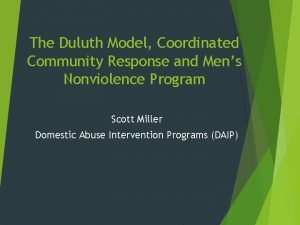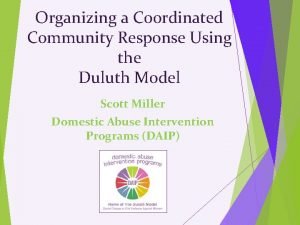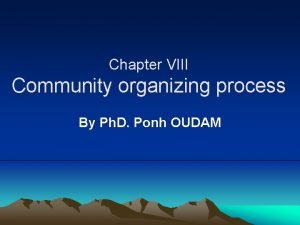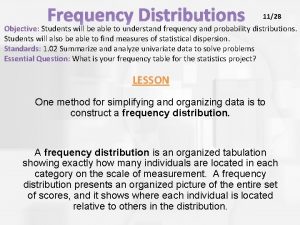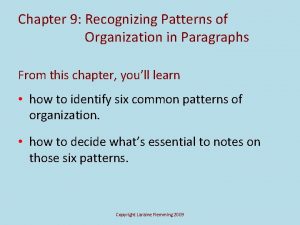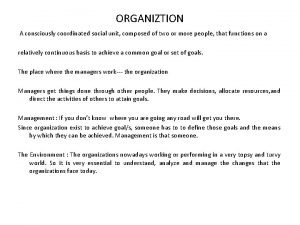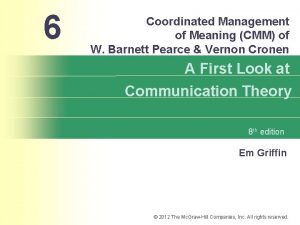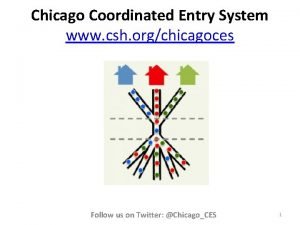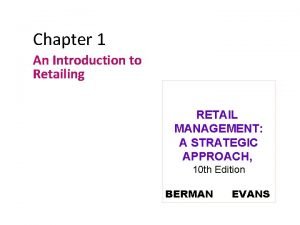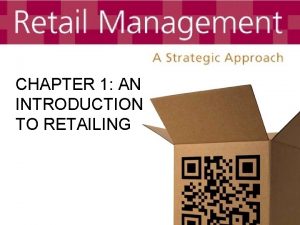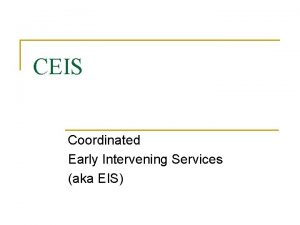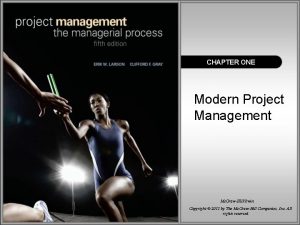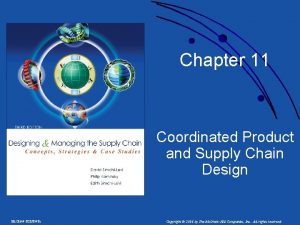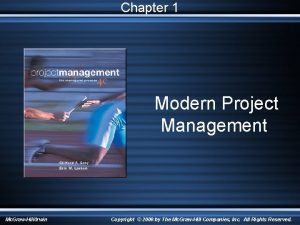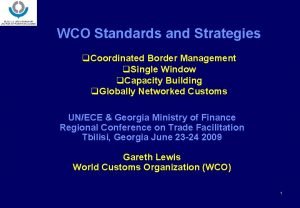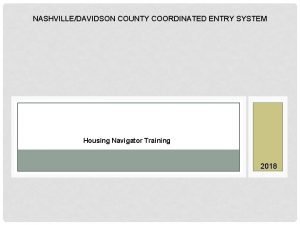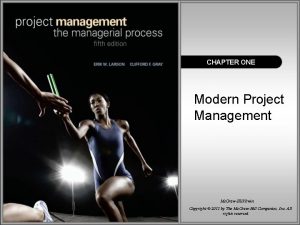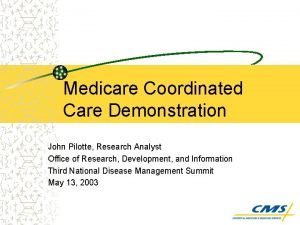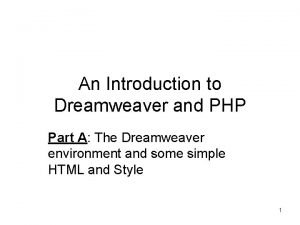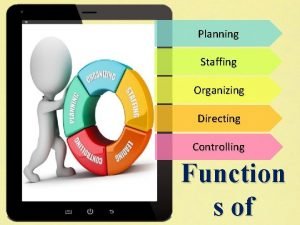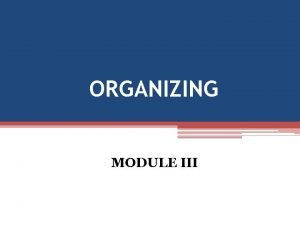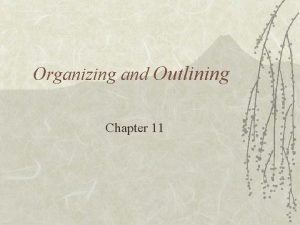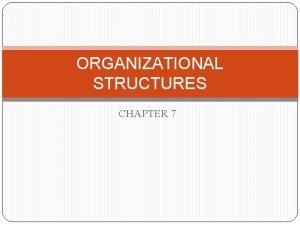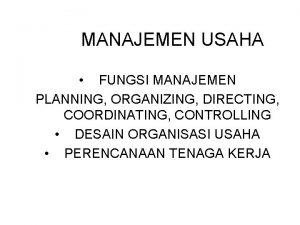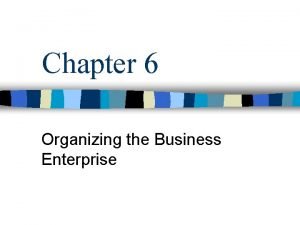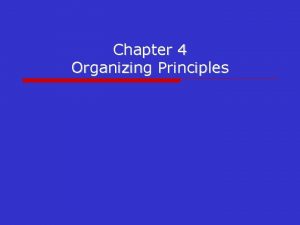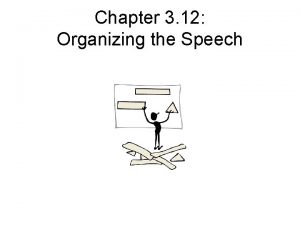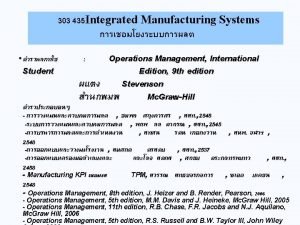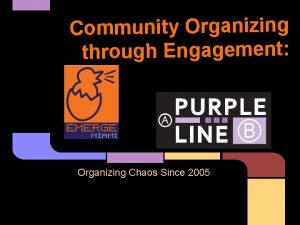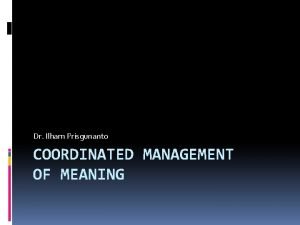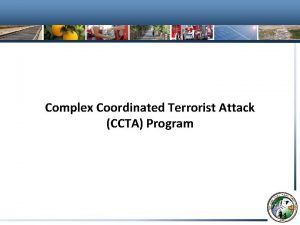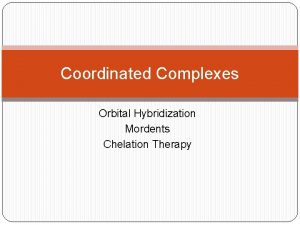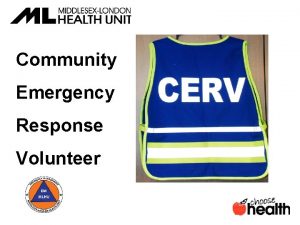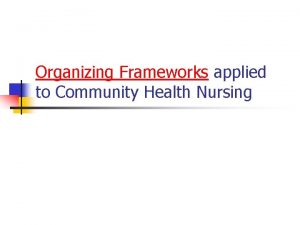Organizing a Coordinated Community Response Using the Duluth







































































































- Slides: 103

Organizing a Coordinated Community Response Using the Duluth Model Scott Miller Domestic Abuse Intervention Programs (DAIP)

The Duluth Model is an organizing method that prioritizes victim safety and offender accountability within a social change framework. The model guides organizers to build interventions within systems that are aligned with the lived experience of victims.

At some level, each agency will have to change Some agencies more than others. Plan, draft, review, approve, train, implement, monitor…. and continue. Listening , learning and sharing will improve interventions and make it possible to create better partnerships.

Exercise in Listening and Learning In triads, ask the question: How have your parents influenced you as an adult?

Core Principles of Social Change is ongoing Approach as a social problem vs. a problem with an individual When organizing, ensure those subject to oppression are included in making changes to the conditions under which they live. Engage in dialogue vs. counsel and advise Create experiences that are liberating rather than dominating

“Any situation in which some individuals prevent others from engaging in the process of inquiry is one of violence. The means used are not important; to alienate human beings from their own decision-making is to change them into objects. ” Paulo Freire, Pedagogy of the Oppressed, Ch. 2, p. 66; Continuum, 1999

The Duluth Model - Informed by and Aligned with the Women’s Movement Analysis of power Integrate social/cultural contexts into interventions Consciousness raising Alignment with those who experience the violence Liberation

Battered Women’s Movement vs Domestic Violence Service Programs Movement: Service Programs • Problem is social • Problem is individual • Fragmented understanding of problem • Intersectional understanding of problem • Addresses underlying causes of violence • Credibility comes from experience and commitment • Focus is primarily to serve/partner with those marginalized by violence to improve living conditions for all. • Addresses symptoms created by violence • Credibility comes from degrees and position • Focus is primarily on organizing to sustain the service even if at the expense of those being served.

Battering and the Crime of Domestic Violence “Later, as laws were enacted in the U. S. to protect women and hold batterers accountable, “domestic violence” took on the gender-neutral meaning of any violence between partners occurring in the context of the home. As a result, every act of violence by one partner against another is now legally considered to be an act of domestic violence” (Pence and Dasgupta, 2006).

Context is Critical Failing to distinguish one kind of domestic violence from another can: Endanger victims of ongoing violence • Result in inappropriate responses by law enforcement, prosecutors and the court, advocates, and counselors • Embolden perpetrators •

The Three Types of Domestic Violence Battering Resistive Situational

Battering An ongoing, patterned use of intimidation, coercion and violence as well as other tactics of control to establish and maintain a relationship of dominance over an intimate partner. Battering is a systematic way of utilizing various tactics to restrict an intimate partner’s autonomy. It is much more than a simple attack.

Relevant Bits of Backstory The Power and Control Wheel was developed in 1984 in partnership with women who had been battered

Characteristics When Battering Is Used In An Intimate Relationship Typically has an element of entrapment: “You can’t leave me without being punished. ” The power differential created by violence shapes all interactions between outsiders and family members. Vulnerability to continued acts of violence influences a victims’ ability to speak freely, leave the relationship, or participate in system interventions.

Oppression and Resistance Partnership Dominance

Understanding Resistance in a System of Control Oppression Resistance

Facilitators of Violence Hierarchy – a social structure where one group or individual is set up to dominate others. Objectification – the process of reducing a person or group to an object. Horizontal Hostility – projecting the violence of oppression onto members of one’s own group. No Consequences – no consequence for violence.

Resistive violence Includes both legal and illegal use of force in response to their abuser’s coercive and controlling tactics, or in reaction to other men’s violence against them as women.

Resistive Violence Part of a victim’s broader strategy to stop (contain) the abuse: Negotiation Appeals to family and friends Appeasement Anger and hostility Separation Withdrawal Use of force

Non Battering Domestic Violence Is used by one intimate partner against the other and is neither an ongoing attempt to exert control, nor a response to control. It encompasses all other acts of domestic violence, which can be subdivided into categories like situational violence or violence that stems from mental health or chemical dependency issues.

Concepts and Theories Includes theories, assumptions and philosophical frameworks Conceptual practices are ingrained in language, assessment tools, and policies Concepts and theories are not owned by a specific individual—they are embedded in institutional practices

Concepts and Theories Why doesn’t she just leave? …She needs to change too How we understand domestic violence guides us in our decision making and frames how we will respond to the situation He is out of Control Using violence is a choice he’s making

The violence is caused by…. Pathology and Disorder Theories Relationship Theories Anger—Cycle of Violence Theory Dominance (Power & Control)

Individual Pathology The batterer has some kind of illness or diagnosis Batterer is the problem – not society Response: Individual psychiatric care, treatment for addiction, or therapy

Relationship Dysfunction “It takes two to tango” The couples are playing off each other Either could stop the violence Both parties are responsible Response: Couples counseling or relationship counseling separately

The Cycle of Violence Theory developed by Lenore Walker • • • Tension-building phase Explosion of violence Honeymoon phase or respite Men socialized to use violence Increases in frequency and severity Popular theory, not supported by research Response: Anger management Domestic Abuse Intervention Project

Dominance System of power and control tactics • • Physical and sexual violence Other abusive behaviors such as emotional abuse Reinforced by the culture Need to balance the power differential by using the power of the state Response: Programs that focus on changing beliefs with tight sanctions by the criminal justice system

Understanding women who are victims of men’s battering

The Sandbag Exercise

What keeps victims from leaving or working with systems? Fear – for violence committed and what he has threatened to do if she leaves. Finance – she and her children rely on his money. They have no independent means to live away from him. Fantasy – She remembers how he treated her when they first met. He says he loves her and he makes promises to change. “Because he was nice in the beginning, he might change…”

What keeps victims from leaving or working with systems? Father – She knows how much the children love/want him. She wants them to know their father. The father has threatened to take/harm the children if she leaves. Family –She’s scared to lose her family or be told it’s her fault the relationship ended. Faith – her religion may tell her to submit and to forgive his violence. She may have been told her God-given role as a woman is to keep the family together.

Factors that can keep women with disabilities from leaving their abuser People with disabilities may take longer to decide to leave due to a lack of community resources or awareness of resources. People with disabilities may rely on others for food, medication, finances and personal care that are necessary for their independence and survival. Leaving may be complicated due to a lack of accessible housing/transportation.

Factors that can keep women with disabilities from leaving their abuser Many people with disabilities share a common experience learned from the community around them which says they are: • Defective • Unable to survive on their own • Stupid • Can’t make it without help These are the same messages men who batter use against their partners which is powerful due to her experience of living with these messages in her life.


Understanding the Risks that Men Who Batter Pose to Their Families

Predictors for Re-offense • • • Gender Time - within first 6 months Younger defendants A prior record for any crime makes him 7 times morel likely commit another domestic assault Being gone on arrival makes him twice as likely to commit another domestic assault On warrant for a prior domestic assault Practical Implications of Current Domestic Violence Research, Andrew Klein 2008

Predictors for Re-offense • Alcohol/drug abuse • Victims perception of risk • • • Unemployed, economically disadvantaged Live in a house with firearms Abuser is not the father of children in home Practical Implications of Current Domestic Violence Research, Andrew Klein 2008

Predictors of Domestic Homicide #1 – Firearms increase lethal violence 6 times over nonlethal violence. Men who threatened to use firearms were 20 times more likely to kill than men who didn’t. Two thirds of men who killed their partners had illegal firearms due to prior domestic assault convictions or an active protective order. Practical Implications of Current Domestic Violence Research, Andrew Klein 2008

Predictors of Domestic Homicide Risk factors that increase lethality 5 times over nonlethal violence. • Threats to kill • Prior attempts to strangle • Forced sex • Escalating physical violence over time • Partner control over victims daily activities Assessing Risk Factors for Intimate Partner Homicide, National Institute of Justice Journal 250

Impact of Arrest on Re-offense Arrest has consistently shown to deter reabuse regardless of reporting party or level of charge. Alternatively, the highest re-abuse rates occurred when law enforcement left the arrest up to the victim. Practical Implications of Current Domestic Violence Research, Andrew Klein 2008

Impact of Prosecution on Re-offence Prosecution alone without regard to an offenders risk does not deter criminal behavior. Prosecution that involves attention to risk and intrusive sanctions like jail and probation and batterer treatment deter domestic assault. Practical Implications of Current Domestic Violence Research, Andrew Klein 2008

What is a Judge to Do? Judges who review risk factors from police reports or protective orders will improve bail/pre-trial release decisions and sanctions at sentencing. Judges should look for past criminal records when making a determination of sanctions on protective orders. Judges should not weigh victim preferences at sentencing as a predictor of risk. Practical Implications of Current Domestic Violence Research, Andrew Klein 2008

What is a Judge to Do? Judges who give deferrals to “first time” offenders will see 25% back with another assault. Judicial demeanor makes a difference in protective order retention and cooperation with prosecution.

How to Predict Risk Accurately “The research consistently finds that the basic information usually available on most defendants provides as accurate a prediction of abuser risk to the victim as more extensive and time consuming investigations involving more sources, including clinical assessments. ” Practical Implications of Current Domestic Violence Research, Andrew Klein 2008 Heckert, D. & Gondolf, E. (June 2004) Battered Women’s Perceptions of Risk Versus Risk Factors and Instruments in Predicting Repeat Reassault, Journal of Interpersonal Violence, 19

Day Two The Duluth Model and Coordinating a Community Response to Domestic Violence

CCR Organizing Models Coordinating Councils Grant driven criminal justice projects Duluth Model

Coordinating Councils A group of governmental and community based agencies that form a committee that meets typically once per month to discuss cases, events, problems. The structure and agenda tends to be led by a criminal justice agency or figure. The power of the group tends to lean criminal justice because of who is in the room. Problems tend to get defined by how they impact the criminal justice system as opposed to victims. Hard to name interagency response gaps due to the number of group members present. Coordinating Councils tend to have high turnover and low commitment.

Grant Driven Justice Projects Grantee tends to be a criminal justice agency who hires or appoints a coordinator to execute the goals and objectives of the grant. Grant is usually awarded to a particular project to improve or add a response. Goals and objectives are accomplished if the response is put in place (new police driven risk assessment, domestic violence court, training judges, specialized investigators, etc. ). The organizing time limited ends with the completion of grant. Typically no ongoing monitoring or evaluation of impact whether it be in victims, offenders or the overall response.

CD Assessment Court Oversees and Sanctions Plan Psych/Mental Health Conditions of Release CHIPS COURT Parenting Education Visitation CP Case Mgmt Individual/Family Therapy Child Placement No Contact Order DV Classes Arraignment Hearing Pre-Trial/ Hearing Trial Sentencing Initial Intervention Unit Contacted Jail Arrest Report Child Protection Screening CP Investigation Non-Arrest Report Arrest Child Welfare Assessment No Arrest Safety Plan Emergency Placement Risk Assessment Safety Assessment Child Maltreatment Assessment Law Enforcement Notified Judge Reviews Squads Investigate Files for Divorce Family Court Hearing Temporary Custody Evaluation 911 Call Advocacy Program Interviews by Evaluator Files OFP Ex Parte Denied Seeks Shelter Landlord/HRA Notified EPC Hearing Service Plan Monitoring/ Probation Warning Given Ex Parte Granted Sheriff Evicts Sheriff Serves Respondent OFP Granted Civil Court Hearing OFP Denied Eviction Hearing Custody Hearing Final Divorce Hearing Custody Awarded Child Support Established OFP Filed Supervised Exchange/ Visitation Reliefs Granted Praxis International, 218 -525 -0487, www. praxisinternational. org

The Duluth Model creates a distinctive form of organized public response to domestic violence. It is characterized by: Clearly identifiable and largely shared assumptions and theories about the source of battering and the effective means to deter it. Ø Empirically tested intervention strategies that build safety and accountability into all elements of processing cases of violence. Ø Well defined methods of inter-agency cooperation guided by advocacy programs. Ø

The Duluth Model Approach Coordinated Community Response (CCR) Individual Advocacy & Shelter 911 Law Enforcement Prosecution Jail Probation Courts Men's Non. Violence Program Restorative Justice Sentencing & Restorative Circles

The Duluth Model: A Guide for Organizing Advocacy agencies coordinate the work of the CCR. Victims and their experience provide the framework for designing and advising the work of the CCR. Interventions need to enhance and be linked to the work of the next agency processing the case. The focus is never on the individual worker. It’s on the policies, protocols and practices that inform the workers actions.

The Duluth Model: A Guide for Organizing Each intervention needs to balance prioritizing victim safety and offender accountability with improving the work experience of the practitioner. Risk information must be collected, analyzed and distributed at the outset of a case so that all agencies are making decisions based on consistent risk data to manage the offender. Practitioners work together in a strategic manner to resolve problems. Most work is done in small groups or individual meetings rather than large monthly meetings.

The Duluth Model: The Importance of Advocacy and Victim Input The Duluth Model provides communities with an approach to coordinating a response to domestic violence. A process that places the needs of victims at the center of a community’s coordinated response. Advocates are organized to prioritize safety for victims Advocates are linked most directly with the lived experience of victims of battering. Advocates are best positioned to organize victim input to identify system gaps, and gather feedback on intervention design and implementation (focus groups or advisory teams)

The Duluth Model: Principles A process that utilizes a consistent set of principles, and a shared understanding of battering to guide the design of each intervention. Six Blueprint for Safety Principles: Adherence to an interagency approach Attention to context and severity of the violence Recognition of domestic violence as a patterned crime requiring continuing engagement Providing swift and sure consequences Sending messages of help and accountability Reducing unintended consequences and disparity of impact www. praxisinternational. org

The Duluth Model: A Shared Understanding There are three types of domestic violence: battering, resistive and non-battering violence. The power of the state should be restricted to controlling the illegal activity of the offender. Victims are rarely free to cooperate with the system to hold offenders accountable. Account for power differences between victim and offender. Batterers are responsible for stopping their violence.

Coordinated Community Response An interagency effort to change the climate of tolerance of battering by: Institutionalizing practices and procedures which centralize victim safety and offender accountability in domestic assault cases. Domestic Abuse Intervention Programs

Activities of a Duluth Model Coordinated Community Response Discover the problems in a system’s response to domestic assault that diminish safety and fail to hold offenders accountable. Organize with agencies to solve those problems using victim experience as the starting point. Track the impact of the interventions to see if the results match the desired intent of the changes.

CCRs Organize interventions accounting for: Safety and Accountability. Policy, protocols and practice that are consistent with organizing principles. Investigate possible unintended consequences toward those who are victimized. Account for the social conditions and culture in which victims experience the violence. Respect for practitioner discretion in these cases.

Making the Violence Visible One of the main outcomes of coordinated community response work is making the violence visible at each point of a criminal justice intervention: Building administrative tools that direct workers to document context that includes the current incident, risk and relationship history. Build a way to analyze and distribute the risk information to all points of cases processing. Done effectively, this can reduce judgment and increase the ability of a CCR to identify systemic problems and high risk individual offenders.

Individual vs. System Issues Individual case issues: Lack skills or training Is not following existing policy or competent practice Is not typical of accepted practices within the agency Systemic issues: Problematic practices resulting from the way the agency organizes workers to do their jobs.

The Role of Interagency Meetings in a Functioning CCR Large CCR meetings: Get input on systemic changes. Announcements like trainings, job shifts, successes, launches and event planning. Small CCR meetings: Organize policy, practice or protocol changes Review data tracking results Strategize institutional change approaches Case review

Eight methods institutions use to coordinate and standardize workers’ actions Safety and Accountability Audit Toolkit ~ Praxis International

Mission, Purpose and Function Mission concerns the overall goals of the organization Purpose refers to specific processes within the mission Function is the function of a practitioner in a specific context How well does the Mission, Purpose, and Function centralize victim safety?

Mission, Purpose and Function Duluth Police Domestic Violence Policy: 310. 1 PURPOSE AND SCOPE The department is committed to engaging in a comprehensive approach to intervening in domestic abuse incidents. The investigation of these cases sets the foundation for almost every subsequent action by the courts and community-based agencies. It is the cornerstone of an effective, coordinated inter-agency response. The intent of the law and this order is to protect victims from ongoing domestic abuse. This order defines the department's procedures in the initial investigation and response to domestic abuse incidents. This order is in compliance with Minnesota Statutes pertaining to police authority and

Rules and Regulations Laws, court rulings or legislative mandates Other types of governmental mandates Internal polices and directives

Administrative Practices Methods that an institution uses as a means of standardizing the way practitioners carry out its policies that include the use of: Texts Forms Report writing formats

Example of an Administrative Practice A way to standardize the collection of risk information from the Duluth Police Department’s domestic violence policy: Do you think he/she will seriously injure or kill you, your children, or someone else close to you? What makes you think so? What makes you think not? Does he/she have access to guns? How frequently does he/she assault you? Describe the time you were the most frightened or injured by him/her. Does he/she initiate unwanted contact either electronically or in person? Describe the unwanted contact. How often? How frequently does he/she intimidate or threaten you? Has he/she intimidated or threatened you regarding talking to police or seeking help from the court? Has he/she ever forced you to do things sexually you didn’t want to?

Risk and Contextual Information Gathered by DPD’s Risk Questions Whether violence is a pattern of abuse Victim’s perception of risk and level of fear Firearms Threats to kill Prior attempts to strangle Forced sex Escalating physical violence over time Stalking Witness intimidation Offender’s entitlement Domestic Abuse Intervention Programs

Resources What workers need to do their jobs. What victims need for safety. What interveners need to hold men accountable.

Linkages How practitioners connect to other workers. How institutions are connected to the people whose cases they process. How information is collected and shared. How problems get resolved.

Accountability How is your agency accountable to victims of battering? How is your agency accountable to other criminal justice and community agencies within the CCR?

Concepts and Theories What assumptions are behind the intervention or policy? Concepts and theories are behind every intervention. It is the work of the CCR to build in the concepts and theories that produce safety and accountability. This includes all language, assessment tools, policies, protocols and practices.

Education and Training How agencies organize their workers to understand their roles and responsibilities. How agencies teach their workers to think about these cases. Understand concepts and theories that underpin roles and responsibilities. Ongoing supervision that enables workers to improve their execution of roles and responsibilities.

Observations, System Gaps and Problem Solving in a CCR

CCR Problem-Solving Identify and document problem Expand understanding of problem, who needs to be involved, analyze, observe, interview, focus groups Implement, problem-solve, refine, integrate into practice. Evaluate for unintended consequences Promote, get everyone on board to implement, provide training Identify sources of problem Approach/involve decision-makers with proposal for change Draft initial proposal for change, check with experts Working group meetings develop solutions

Analyzing Focus Group Notes as a Means of Creating Change What is the impact on women who are battered when violations of order for protections take place and law enforcement is called. List themes. What are your next steps to determine the source of the problem you’ve uncovered from the focus group. As a group, speculate and agree on a particular source of the problem and use the Eight Methods to map out your solution/new intervention.

Day Three Components of a CCR Developed with the Duluth Model

Analyzing Focus Group Notes as a Means of Creating Change Read these focus group notes transcribed from a recording. List themes you see. Remember, you’re looking for impact themes, not naming the source of the problem. As a group, talk about what themes are present. Pick one theme and detail a plan on how you would further investigate the source of the problem.

Tracking and Monitoring Tracking is used to determine if a problem trend exists (does a downward plea impact recidivism) Monitoring is used to determine if established policies or procedures are improving over time (e. g. , Are police asking risk questions? ) Data is always designed and used to improve the community’s response to domestic assault.

Methods of Tracking and Monitoring Focus groups Reading reports/case files Reviewing criminal justice data bases Observation Specialized domestic violence database

What Does Tracking and Monitoring Do? Provides data to system advocates and system professionals Trends Identify system gaps Adherence to new policy and procedures Service to partner agencies Improves advocacy for battered women and children

What Does Tracking and Monitoring Require? Relationships Trust based on relationship and understanding. Track record of being useful to CJS agencies. Access Understand what you need. Understand what partner agencies need. Who are your allies? Integrity, responsibility and honesty.

What Does Tracking Monitoring Require? Access, agreements and data • • Draft Memorandums of Understanding. Be clear what will be done with reports. Clearly state how the reports will be handled. How will it be decided which data to use? How will data be accessed? Who will make the data available? How will be kept and who will have access?

How Will Data Be Used? Internal All reports start internal. Create a review process for all reports that will be external. External Meetings that are multidisciplinary, single agency or used as supervisory tool. Other uses might be grant reporting or responding to a specialized request from a CJS agency.

Defining Success in a CCR What is organized has an impact on victims and those who batter. Victim input and experience is reflected in the changes made. CJS agencies experience an improved work experience and outcomes. Meetings are useful to everyone. Change is slow but it’s change (don’t expect more than what the system can give at any one point in time). Tracking efforts show improved outcomes. Trust exists between community agencies and CJS. Community advocates are a resource.

Ongoing Evaluation of Recidivism in Duluth’s CCR Re-offenses defined as arrests, non-arrests, citations and granted protection orders within eight years of last class date. 1/1/98 to 12/31/99 (N=353) 29% overall recidivism (includes both men who completed and not completed class) 1/1/04 to 12/31/05 (N=326) 34% overall recidivism 29% recidivism for men who completed class 41% recidivism for men who did not Counting all men in both evaluations, approximately 7 out of 10 of our male offenders won’t end up back in the criminal or civil justice system 8 years from their last point of contact with the system.

Community Programs within a Coordinated Community Response Advocacy Programs Men’s nonviolence programs Programs for women arrested Visitation Center Family Justice Center

DAIP’s Men’s Nonviolence Program Integrated component of Duluth’s CCR Formal partner with community advocacy programs Has access to all LE reports, OFPs, risk analysis, imposed sentence, probation conditions, visitation center records and initiates victim contact Probation receives bi-weekly reports from DAIP on men’s status, attendance record Meets the same Duluth Model principles and shared understanding as the rest of the CCR (includes curriculum). Provides classes for court ordered and volunteer men, women and education groups for female victims.

The Men’s Nonviolence Program in a Coordinated Response The struggle with many coordinating efforts today is the lack of accountability the rehabilitation programs have to the CCR and to victims of battering.

Facilitating Men’s Group in a Social Change Framework Dialogue is the medium of learning. Work with lived experience rather than theory (Cycle of Violence). Education is never neutral – conversations with oppressed people either function to domesticate or liberate. Challenge without judgment. Encourage critical thinking. Simultaneously work with the potential the men bring and the threat they pose.

Principles of a Duluth Model Men’s Nonviolence Program The program purpose is to increase the safety of women and children. The reference point for understanding battering is the experience of women who have been battered. The program focus is on deconstructing men’s historical and socially constructed entitlement to be violent to women.

Principles of a Duluth Model Men’s Nonviolence Program An ongoing, formal relationship with shelter/court advocates is a critical part of providing safety for women and children. Critical dialogue is central to creating an educational process of change for men who batter.

Principles of a Duluth Model Men’s Nonviolence Program The men’s nonviolence program recognizes and responds to the advocacy, safety and empowerment needs of the women whose partners are in the program. The men’s nonviolence program is a component of a larger interagency response to battering.

Control Log Actions Intents Beliefs Feelings Minimization, Denial, and Blame Effects On you On her On others Past Violence Noncontrolling Behaviors

911 call Used from Addressing Fatherhood With Men Who Batter Advocates for Family Peace Grand Rapids and Hibbing, MN (Scaia, Connelly, Downing)

Parenting Classes: How to get Children to Clean Their Room Action: Beliefs: Listen My child can learn Praise A child needs time Set goals My child isn’t an adult Intent: A child needs space Teach Child feels part of it Build self-esteem Know what’s expected

Parenting Classes: How to get Children to Clean Their Room Action: Beliefs: Get child to listen What I say goes Set expectation I’m the boss/own you Set consequences Discipline is needed Intent: I get to yell/use threats Clean room Child knows what to do Teach child responsibility

The Problem with Anger Management and Men who Batter Anger Mgmt – Focused heavily on feelings, specifically anger, anger cues and skills to “stop” the anger or re-direct thinking that causes it. Use of anger control plans (timeouts, breathing exercises, physical exercise, talk to a friend, explore feelings beneath the anger). Asks that anger be managed rather than fundamentally change who the man believes he is and entitlement he has over women.

Finding an Organizer Grounded in victim’s experience of battering and why men batter Confident/not intimidated by positions of power Organized and patience that comes from vision Can SEE systems/big picture Can write and likes to read – a lot. Credible/can hold confidence/build trust

Finding an Organizer ü ü ü Doesn’t have a confrontational nature or track record Likeable, collaborative, smart and curious Knows how to balance usefulness to the system and allegiance with victims of battering. Asks questions/asks questions Has time to develop and is not responsible for individual advocacy

Next Steps in Your CCR With your community partners, answer the following questions: What structural changes need to be addressed (accountability to each other, victims. Meeting format or focus, etc. )? What do you know about how your current practices impact victims of battering? What would be a next step? Does your CCR response focus more on how to manage offenders and victims or is it designed to improve the lives of those you serve? What are key agenda items for your next meeting?

Resources Domestic Abuse Intervention Programs www. theduluthmodel. org Domestic Violence Turning Points www. dvturningpoints. com Advocates for Family Peace www. stopdomesticabuse. org Battered Women’s Justice Project www. bwjp. org Casa de Esperanza www. casadeesperanza. org Mending the Sacred Hoop Technical Assistance Project www. msh-ta. org Praxis International www. praxisinternational. org
 Coordinated community response training
Coordinated community response training Duluth model
Duluth model 1 primerica parkway
1 primerica parkway Security shutters duluth mn
Security shutters duluth mn The duluth model
The duluth model Duluth energy design conference
Duluth energy design conference Core group formation meaning
Core group formation meaning Organizing data using frequency distribution
Organizing data using frequency distribution Recognizing patterns of organization
Recognizing patterns of organization Natural and forced response
Natural and forced response First order system transfer function
First order system transfer function Primary immune response and secondary immune response
Primary immune response and secondary immune response Community response unit
Community response unit A consciously coordinated social unit
A consciously coordinated social unit Serpentine model cmm
Serpentine model cmm Snohomish county coordinated entry
Snohomish county coordinated entry Coordinated management of meaning theory examples
Coordinated management of meaning theory examples Edcd waiver fact sheet
Edcd waiver fact sheet Csh chicago
Csh chicago The retailing concept
The retailing concept Coordinated effort in retailing concept
Coordinated effort in retailing concept Coordinated early intervening services
Coordinated early intervening services Coordinated early intervening services
Coordinated early intervening services A series of coordinated related multiple projects
A series of coordinated related multiple projects A series of coordinated related multiple projects
A series of coordinated related multiple projects Chapter 1 modern project management
Chapter 1 modern project management Coordinated product and supply chain design
Coordinated product and supply chain design A series of coordinated related multiple projects
A series of coordinated related multiple projects Coordinated entry
Coordinated entry Wco 10 building blocks
Wco 10 building blocks Coordinated entry system nashville
Coordinated entry system nashville A series of coordinated related multiple projects
A series of coordinated related multiple projects A series of coordinated related multiple projects
A series of coordinated related multiple projects Achn medicaid
Achn medicaid Medicare coordinated care demonstration
Medicare coordinated care demonstration All india coordinated research project
All india coordinated research project Coordinated plan on ai
Coordinated plan on ai Coordinated engagements
Coordinated engagements Web authoring using adobe dreamweaver - selected response
Web authoring using adobe dreamweaver - selected response Hình ảnh bộ gõ cơ thể búng tay
Hình ảnh bộ gõ cơ thể búng tay Lp html
Lp html Bổ thể
Bổ thể Tỉ lệ cơ thể trẻ em
Tỉ lệ cơ thể trẻ em Voi kéo gỗ như thế nào
Voi kéo gỗ như thế nào Tư thế worms-breton
Tư thế worms-breton Hát lên người ơi alleluia
Hát lên người ơi alleluia Kể tên các môn thể thao
Kể tên các môn thể thao Thế nào là hệ số cao nhất
Thế nào là hệ số cao nhất Các châu lục và đại dương trên thế giới
Các châu lục và đại dương trên thế giới Công thức tính độ biến thiên đông lượng
Công thức tính độ biến thiên đông lượng Trời xanh đây là của chúng ta thể thơ
Trời xanh đây là của chúng ta thể thơ Mật thư tọa độ 5x5
Mật thư tọa độ 5x5 101012 bằng
101012 bằng Phản ứng thế ankan
Phản ứng thế ankan Các châu lục và đại dương trên thế giới
Các châu lục và đại dương trên thế giới Thơ thất ngôn tứ tuyệt đường luật
Thơ thất ngôn tứ tuyệt đường luật Quá trình desamine hóa có thể tạo ra
Quá trình desamine hóa có thể tạo ra Một số thể thơ truyền thống
Một số thể thơ truyền thống Cái miệng nó xinh thế chỉ nói điều hay thôi
Cái miệng nó xinh thế chỉ nói điều hay thôi Vẽ hình chiếu vuông góc của vật thể sau
Vẽ hình chiếu vuông góc của vật thể sau Thế nào là sự mỏi cơ
Thế nào là sự mỏi cơ đặc điểm cơ thể của người tối cổ
đặc điểm cơ thể của người tối cổ Ví dụ giọng cùng tên
Ví dụ giọng cùng tên Vẽ hình chiếu đứng bằng cạnh của vật thể
Vẽ hình chiếu đứng bằng cạnh của vật thể Fecboak
Fecboak Thẻ vin
Thẻ vin đại từ thay thế
đại từ thay thế điện thế nghỉ
điện thế nghỉ Tư thế ngồi viết
Tư thế ngồi viết Diễn thế sinh thái là
Diễn thế sinh thái là Dạng đột biến một nhiễm là
Dạng đột biến một nhiễm là Số nguyên tố là số gì
Số nguyên tố là số gì Tư thế ngồi viết
Tư thế ngồi viết Lời thề hippocrates
Lời thề hippocrates Thiếu nhi thế giới liên hoan
Thiếu nhi thế giới liên hoan ưu thế lai là gì
ưu thế lai là gì Hươu thường đẻ mỗi lứa mấy con
Hươu thường đẻ mỗi lứa mấy con Khi nào hổ con có thể sống độc lập
Khi nào hổ con có thể sống độc lập Sơ đồ cơ thể người
Sơ đồ cơ thể người Từ ngữ thể hiện lòng nhân hậu
Từ ngữ thể hiện lòng nhân hậu Thế nào là mạng điện lắp đặt kiểu nổi
Thế nào là mạng điện lắp đặt kiểu nổi Plan together in community mobilization
Plan together in community mobilization Chapter 2 skills and applications
Chapter 2 skills and applications Using system using system.collections.generic
Using system using system.collections.generic Dtfd switch
Dtfd switch Introduction of portfolio
Introduction of portfolio Staffing and directing
Staffing and directing Organizing committee structure for an event
Organizing committee structure for an event Structure follows strategy
Structure follows strategy Planning organising staffing directing controlling
Planning organising staffing directing controlling Marzano element 15
Marzano element 15 Organizing steps
Organizing steps Organizing and drafting business messages
Organizing and drafting business messages Organizing an outline
Organizing an outline Organizing in management
Organizing in management Directing manajemen
Directing manajemen Organizing data in a traditional file environment
Organizing data in a traditional file environment Manager is someone who
Manager is someone who Vocabulary in discourse
Vocabulary in discourse How did chemists begin the process of organizing elements
How did chemists begin the process of organizing elements Organizational structuring
Organizational structuring Group five elements
Group five elements Organizing principles
Organizing principles Organizing a speech
Organizing a speech

